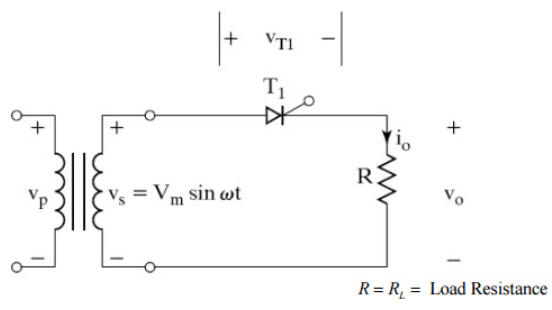Principle of Phase Control | Power Electronics - Electrical Engineering (EE) PDF Download
What is a Phase Controlled Rectifier?
- The term PCR or Phase controlled rectifier is a one type of rectifier circuit in which the diodes are switched by Thyristors or SCRs (Silicon Controlled Rectifiers). Whereas the diodes offer no control over the o/p voltage, the Thyristors can be used to differ the output voltage by adjusting the firing angle or delay.
- A phase control Thyristor is activated by applying a short pulse to its gate terminal and it is deactivated due to line communication or natural. In case of heavy inductive load, it is deactivated by firing another Thyristor of the rectifier during the negative half cycle of i/p voltage.
Types of Phase Controlled Rectifier
The phase controlled rectifier is classified into two types based on the type of i/p power supply. Single-phase Controlled Rectifier
This type of rectifier which works from single phase AC i/p power supply.
Single Phase Controlled Rectifiers are classified into different types
- Half wave Controlled Rectifier: This type of rectifier uses a single Thyristor device to provide o/p control only in one half cycle of input AC supply, and it offers low DC output.
- Full wave Controlled Rectifier: This type of rectifier provides higher DC output
- Full wave controlled rectifier with a center tapped transformer requires two Thyristors.
- Full wave bridge controlled rectifiers do not need a center tapped transformer
Three-phase Controlled Rectifier
This type of rectifier which works from three phase AC i/p power supply.
- A semi converter is a one quadrant converter that has one polarity of o/p voltage and current.
- A full converter is a a two quadrants converter that has polarity of o/p voltage can be either +ve or –ve but, the current can have only one polarity that is either +ve or -ve.
- Dual converter works in four quadrants – both o/p voltage and o/p current can have both the polarities.
Operation of Phase Controlled Rectifier
- The basic working principle of a PCR circuit is explained using a single phase half wave PCR circuit with a RL load resistive shown in the following circuit.
- A single phase half wave Thyristor converter circuit is used to convert AC to DC power conversion. The i/p AC supply is attained from a transformer to offer the required AC supply voltage to the Thyristor converter based on the o/p DC voltage required. In the above circuit, the primary and secondary AC supply voltages are denoted with VP and VS.

- During the +ve half cycle of i/p supply when the upper end of the transformer secondary winding is at a + ve potential with respect to the lower end, the Thyristor is in a forward biased state.
- The thyristor is activated at a delay angle of ωt =α, by applying an appropriate gate trigger pulse to the gate terminal of thyristor. When the thyristor is activated at a delay angle of ωt =α, the thyristor behaviors and assuming a perfect thyristor. The thyristor acts as a closed switch and the i/p supply voltage acts across the load when it conducts from ωt =α to π radians For a purely resistive load, the load current io that flows when the thyristor T1 is on, is given by the expression.
Io= vo/ RL, for α≤ ωt ≤ π
Applications of Phase Controlled Rectifier
Phase controlled rectifier applications include paper mills, textile mills using DC motor drives and DC motor control in steel mills.
- AC fed traction system using a DC traction motor.
- electro-metallurgical and Electrochemical processes.
- Reactor controls.
- Magnet power supplies.
- Portable hand instrument drives.
- Flexible speed industrial drives.
- Battery charges.
- High voltage DC transmission.
- UPS (Uninterruptible power supply systems).
Some years back AC to DC power alteration was attained using mercury arc rectifiers, motor generator sets, and Thyrator tubes. The modern AC to DC power converters are intended to high current, high power Thyrator s. Presently, most of the AC to DC power converters are thyristorised. The Thyrator devices are phase controlled to get a variable DC o/p voltage across the output load terminals. The phase controlled Thyrator converter uses AC line commutation for turning off the Thyristors that have been switched ON.
These are less expensive and also very simple and widely used in industrial applications for industrial DC drives. These converters are categorized as two quadrant converters if the o/p voltage can be made either + ve or -ve for a given polarity of o/p load current. There are also single quadrant AC-DC converters where the o/p voltage is only +ve and cannot be made –ve for a given polarity of o/p current. Of course, single quadrant converters can also be designed to deliver only -ve DC o/p voltage. The operation of two quadrant converter can be attained by using fully controlled bridge converter circuit and for a single quadrant process we use a half controlled bridge converter.
|
5 videos|67 docs|46 tests
|
















